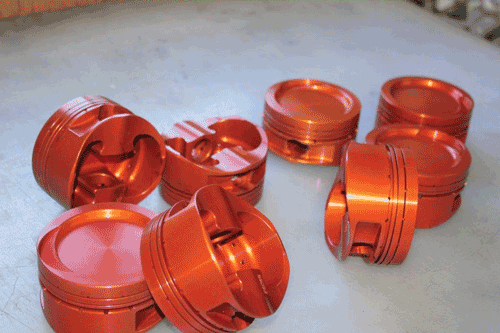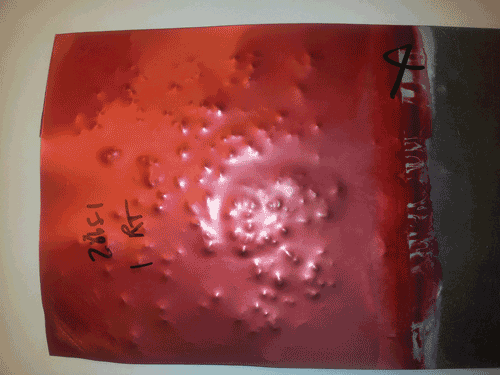DiamonDyze in the Rough
A pair of coaters—who are also racing enthusiasts—say they have made a significant advance in aluminum anodizing using ceramics to produce an extremely hard, corrosion- and wear-resistant anodic oxide coating.
Leonard Warren of Tech-Line Coatings in California and Dale Hupe of Hupe Manufacturing in Canada have already won over a number of finishers with their DiamonDyze process, which they also describe as ceramic anodizing.
Dave Roach of Peninsula Metal Finishing in Orlando, Fla., says he began using the DiamonDyze process in 2011 and has since anodized parts in various colors for building door hardware, and automotive, marine and sporting goods.
“The ability to obtain color along with superior wear and corrosion resistance with Type II anodize is a real selling point,” Roach says. “Our in-house salt spray test on 7075 forgings ran 1,400 hrs before a slight corrosion appearance.”
Tapio Niivila, president of Ride Concepts, an Ontario, Canada, manufacturer of fork and shock pistons in the motocross suspension revalve industry, had the coating applied to the outer fork tubes of his own motorcycle.
“What an impressive coating,” he says. “There was noticeable decrease in static friction and improvement from sliding frictions in the forks.”
The Process
The first stage of the DiamonDyze anodizing process is conventional, using an aqueous acid electrolyte. The “breakthrough,” Warren and Hupe say, comes at the following stage, where the freshly anodized aluminum is immersed in a solution that contains a proprietary additive that includes finely divided ceramic particles. They won’t disclose the composition of this solution, although they say it is otherwise very much the same as the classical dye coloring process for anodized aluminum.
Finally, the surface can be sealed using conventional nickel acetate, hot water, steam or other means, although it may not be necessary.
Warren says the ceramic particles in the additive are impregnated into the anodic oxide alumina pores, thus constricting them to prevent oxidation of any metallic aluminum not previously done in the electrochemical process and also to largely fill the porous structure. He adds that this is one reason why final sealing becomes less important than in conventional anodizing.
Although the process is not yet patented, the inventors say they are confident that it’s complex enough that there is no threat of reverse engineering by competitors. They say the proprietary chemicals are added to the immersion solution in very small amounts, on the order of 2.5 ml additive per liter water. The immersion solution then adopts the pH of the dyestuff used; in the absence of dyestuff, the pH is approximately 6.
Lower Roughness
Warren and Hupe, who emphasize the absence of any toxic or environmentally undesirable chemicals in their process, say DiamonDyze works on a wide range of aluminum alloys, including cast aluminum and the commercially important types 2024 and 6061, where Type II and Type III anodizing can be carried out.
Data show that surfaces anodized through the new process have far lower roughness than those processed with conventional anodizing, and that surface roughness is usually less than that of the original unanodized aluminum substrate.
Those results have attracted several European customers, especially those in the motor racing industry.
Andy Robinson of Robinson Race Cars in the United Kingdom recently became aware of the DiamonDyze process and sent some adjustable aluminum front strut mountings machined from 6082 T6 aluminum from his 2,800-hp Pro Mod drag racing car to be coated.
“Because the race car is a very harsh environment for components, the durability of the DiamonDyze finish was a key consideration,” Robinson says. “We were also very impressed by the fact that it does not add appreciably to the dimensions of the item coated, and so our precision-machined parts still fit together beautifully. The coating is an attractive finish, and we will be using it on many more components in the future.”
Wear Resistance of Ceramic
Markus Martelius of MD Martelius Exhaust in Finland had a set of race pistons DiamonDyzed with an additional ceramic coating applied to the crowns and was very pleased with the results.
“The ability to combine the wear resistance of ceramic anodizing with the lubricity and thermal insulation of polymer ceramic coatings is a unique and highly beneficial combination,” Martelius says. “We expect to see performance and durability gains as obtained by other users of DiamonDyzed pistons.”
Using their close links to the motor sport industry, Warren and Hupe have coated and tested engine pistons and rings in a standard 5-L engine connected to a dynamometer. Because of reduced frictional loss, their test results show about 6 percent increases in both horsepower and torque, which is good for potential fuel savings. After testing, they dismantled the engine and found the pistons and rings in pristine condition.
But Warren and Hupe say the greatest strength of the process is in the corrosion resistance, especially in results of salt spray tests per ASTM B117. In addition to use of standardized B117 testing, anodized samples have also been exposed to an in-house variation of B117, whereby the cabinet is operated for 12 hrs a day with samples resting overnight in the cabinet, exposed to air. Comparison of the two tests showed—as might be expected—that the latter is more severe on the basis that counted hours are only for spray in operation and exclude rest periods. Properties of the new coating are summarized in Table 1, but endurance values (hours) in the salt spray tests are not hours to failure, because after no traces of corrosion, Warren and Hupe felt it pointless to continue past 8,400 hrs. In the second case, the tests continued, and they say the 2,000 hrs represents the current status with no evident corrosion.
Smaller Outward Growth
To demonstrate DiamonDyze’s coating hardness, a metal file was applied to the coating, and the file teeth were damaged rather than the coating itself. Another example is the dimensional change after anodizing, a key issue when precision engineering components are involved. Normally, the aluminum oxide grows about 70 percent inward and 30 percent outward from the original surface. In the case of Diamondyzing, test results show a much smaller outward growth, often as little as five percent, with as much as 95 percent of the growth being inward.
As for corrosion and wear resistance, the inventors say numerous tests confirm the exceptional properties of the new coating. While the use of dye to color anodized samples has no significant effect on wear- or corrosion-resistance properties, it can act as a useful “tell-tale sign” since any loss of coating by corrosion or wear also removes the outer coloring, they say.
In Taber Abrader tests, results showed 40,000 cycles completed with no visible wear or weight loss. In another test, two aluminum collars—one as-received, the other DiamonDyze anodized—were mounted in a lathe and rotated while a handheld file was applied. The results are seen in the image directly above, with the grooved surface of the untreated sample contrasted with the almost pristine dyed and treated sample. In terms of corrosion, the image at the top left of this page shows a DiamonDyzed aluminum test panel constructed entirely of stainless steel and exposed for one year in an inorganic fertilizer plant. The stainless steel screw used to attach the test piece was corroded, but the test panel itself reportedly remains intact.
Process control for the second, immersion stage is straightforward: The DiamonDyze additive is replenished on the basis of the surface area of work throughput. In addition, a simple acid-base titration to monitor pH is used at regular intervals. Warren and Hupe are doing further trials by anodizing automotive engine pistons with the new approach, as well as similarly anodizing the cylinder bores of aluminum engine blocks.
Convincing New Customers
Mark Parsons, plating manager at Secoa Technology in Dalton, Ga., says he is now offering the DiamonDyze process to customers.
“I was intrigued by the literature and website information, but a little apprehensive at first,” says Parsons, who, before committing to it himself, sent test parts to a friend who has a plating shop in Florida that was already using the process.
Parsons did a side-by-side mechanical rub test using Scotch Brite Pads on DiamonDyzed parts versus some processed using his normal anodize process. After 6,000 rubs, the normal-anodized part had broken down and exposed base alloy, while Parsons says the DiamonDyze part looked slightly glossier or polished, but with very little loss of material.
“The DiamonDyze part looked practically untouched, and our management team was impressed to say the least,” he says, adding that Secoa is using the new anodizing process on parts that will be used in the robotic welding, appliance, carpet, textile, firearms, automotive and food industries.
Warren and Hupe say initial success has also been achieved in bonding dry film lubricants and thermal barrier coatings onto DiamonDyze surfaces, as would be required to optimize engine performance. They add that resin-based clearcoats have also been applied without problems, all of which improved increased engine performance in terms of thermodynamics and lubricity. .
Dr. Anselm T. Kuhn is with Metal Finishing Information Services in the U.K. He can be reached at office@finpubs.com.
Related Content
Top Shop Aces Outstanding Customer Service
More than a finishing shop, this anodizing, powder coating and vacuum resin impregnating business goes above and beyond for its customers by being a resource for whatever their finishing needs might demand.
Read MoreAnodizing for Bonding Applications in Aerospace
Anodizing for pre-prep bonding bridges the gap between metallic and composite worlds, as it provides a superior surface in many applications on aluminum components for bonding to these composites.
Read MoreCorrosion Protection Options for Aluminum
Seeking to understand aluminum corrosion and prevention? Jacob Weingart of Columbia Chemical offers a helpful overview of corrosion protection options for aluminum and its alloys.
Read MoreRead Next
Overview: Aerospace Anodize Finishes
The following anodizing process overviews are provided as a means of introduction to aerospace anodizing
Read MoreDelivering Increased Benefits to Greenhouse Films
Baystar's Borstar technology is helping customers deliver better, more reliable production methods to greenhouse agriculture.
Read MoreA ‘Clean’ Agenda Offers Unique Presentations in Chicago
The 2024 Parts Cleaning Conference, co-located with the International Manufacturing Technology Show, includes presentations by several speakers who are new to the conference and topics that have not been covered in past editions of this event.
Read More












.jpg;maxWidth=300;quality=90)











